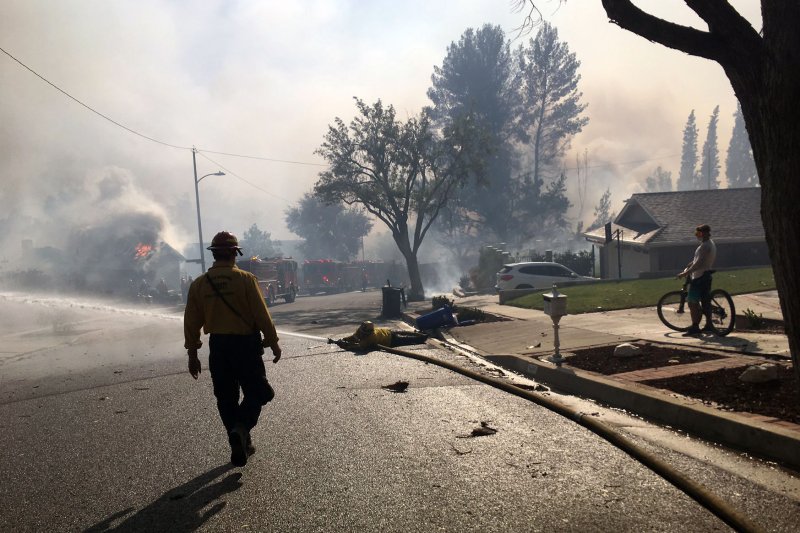Members of a Santa Barbara County Fire Department 8, in Calabasas, California, fighting the Woolsey Fire in Calabasas, Calif., on are pictured on November 9. Fire officials predict the upcoming wildfire season in the United States could be worse than last year. Photo courtesy Battalion Chief David Neels/Santa Barbara County Fire Department/UPI |
License Photo
As the Southwest is drying out, the threat for wildfires is ramping up and will continue to do so through July; however, if the monsoon season is weak as AccuWeather meteorologists expect, that threat could last into August.
Wildfires have already been sparking across the country in the last week alone, with blazes breaking out in California and Alaska, as well as in parts of Arizona.
U.S. Forest Service and Interior Department officials recently warned senators that the upcoming wildfire season would be worse than last year's, which killed hundreds of people and caused billions of dollars in damages, CNN reported.
The fire season typically doesn't become a big threat until late summer and into fall for the Northwest, but looking at the fire outlook, AccuWeather Meteorologist Paul Pastelok said conditions are favorable in parts of the Southwest for development now.
"Already big fires have been reported in California and up in northern areas of British Columbia. The forecast shows a threat of fires may continue all the way into October," Pastelok said.
Northern California is more susceptible to bigger fires, due to all of the precipitation during the winter and spring months, this season. In some places in Northern California, the fire threat last through September and into October.
"The Northwest is where we have highlighted since late winter and early spring in our long-range forecasts. Moisture over the winter and spring has created good growth this season. Long stretches of dry and hot weather in late spring have dried out many areas already and this is just the start of what could be a very bad fire season for the Northwest," Pastelok said.
The Southeast is getting rain and for most areas that will decrease the chances for brush fires and wildfires, but isolated areas are still possible.
For California, Pastelok said elevations above 6,000 feet will see delayed delayed wildfire threat because snowpack is expected to hold through late June and possibly into July in certain spots.
"Conditions are more favorable below 6,000 feet, especially July and beyond. Bigger concerns are for the Northwest and western Canada where upper pattern favors upper-level highs for long periods through the summer and early fall," Pastelok said.
It is the lower mountainous areas with significant fuels and where more people may threaten to start fires at risk.
Areas of Alaska are also in the line of fire due to previous wet conditions that have promoted the growth of brush, which is now drying out.
Lisa Murkowski, a Republican Senator from Alaska, said said this week that the upcoming months will have "elevated wildfire activity." She cited a National Interagency Fire Center monthly wildland fire potential outlook, which covers the period from June through September -- and Murkowski pointed to the recent fires that have broken out this month already.
"They are now getting into their dry season in eastern Alaska and some fires have started, which is normal I believe," Pastelok said.
Fires can have numerous negative effects, including poor air quality and larger blazes could cause air quality to worsen in many areas of the Northwest and western Canada.
On the bright side, some much-needed moisture might be in store. In the Southwest, AccuWeather meteorologists expect a weaker monsoon season, but that does not mean that the season will be dry. Some unusual upper disturbances triggering rainfall, and tropical moisture from the eastern Pacific could lead to near- to above-normal rainfall, but keep in mind normal precipitation amounts are low in this region during mid-summer.
The chance of tropical rain is higher later in summer and in early fall in California, Arizona and Nevada.
"We do feel that the warmer waters stretching from southeast Hawaii north and east can drive some tropical moisture into southern and Central California, Nevada, and western Arizona later in the summer and Fall," Pastelok added.















